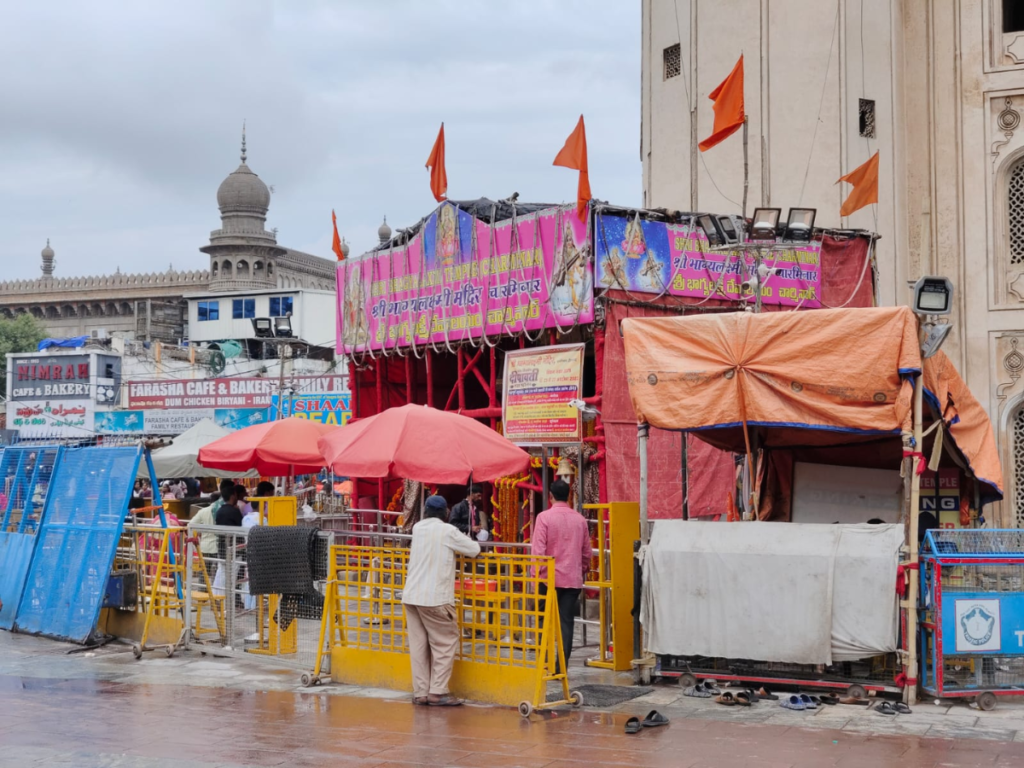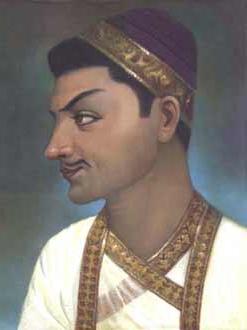Hyderabad: It is no secret that the Bhagyalaxmi temple’s existence on the historic Charminar is a matter of dispute. Regardless of the fact that it is in fact an unauthorised construction, the temple seems to be slowly expanding in the area bit by bit.
Heritage lovers and activists point out that post the COVID-19 lockdown, the Bhagyalaxmi temple at the Charminar began taking up more space. The temple, situated in Hyderabad’s Old City, today pretty much has occupied the entire north-east minaret of the monument, thanks to police barricades around it. All of it has only aided the expansion.
The Bhagyalaxmi temple has also become more and more prominent thanks to political patronage it has been getting from some years. The Bharatiya Janata Party (BJP) has also regularly makes it a point to begin its important programmes from there. Activists point that even state ministers and other leaders from the ruling TRS visit it and seek blessings from god, thereby legitimising it.
“The police has added barricades and poles (recently). Politically, after 2015 the temple began gaining importance. In 2012 a case was filed against the Bhagyalaxmi temple’s expansion. The high court court closed it saying that it should not expand any further. The ASI has failed to protect the Charminar,” said SQ Masood, an activist from Hyderabad’s Old City.

The Archaeological Survey of India (ASI) has in fact on more than one occasion maintained that the temple on the Charminar is unauthorised. The Bhagyalaxmi temple came up in the 1960s, and has since been there. The monument was built in 1591 as Hyderabad’s foundation by Mohd Quli Qutb Shahi, the city’s founder.
Prior to the Charminar being built, the Golconda fort (in Telangana) was a walled city, from where the first three kings Qutb Shahi kings had ruled. The Golconda or Qutb Shahi dynasty existed from 1518 to 1687, until Hyderabad was conquered by the Mughals.
No such details available: ASI on Hyderabad – Bhagyanagar name
The temple’s origin
The Charminar was built in 1591 as the foundation of Hyderabad, when Mohd Quli Qutb Shah decided to move out of the Golconda fort. His built upon the idea of his father, Ibrahim Qutb shah, to built a new city.
According to old timers who have seen the temple come up, the Charminar had four milestone markers around it originally. “A woman labourer had passed away while working in front of it in the 1960s. In those days it was difficult for them to go back home for last rites, so they would get buried wherever they pass away. Hence the lady was buried in front of the monument,” said Oudesh Rani Bawa, 75, an old-timer whose interests lie in Urdu in the Deccan.

She added that after the woman was buried, her daughter would sit outside the Charminar and as for alms. “Eventually in the late 1960s local groups seized the opportunity and built a temple which has since remained there,” Bawa told this reporter about the Bhagyalaxmi temple recently during an interview.
Masood added that the district administration including GHMC has also “aided” the unauthorised Bhagyalaxmi temple by giving it a power line. “Whatever the MA&UD is planning as part of its Charminar urban project now, it should focus on protection of the Charminar,” he told Siasat.com.
The ASI, which is the custodian of the Charminar and the Golconda fort in Hyderabad, has also been writing letters to the state over decades to shift the unauthorised construction. This was also mentioned by former ASI superintending Archaeologist of Hyderabad circle Milan Kumar Charley during a talk on the monument in 2019.
Like the temple, there also exists a Dargah inside the monument which is unauthorised. However, that does not extend the way the temple does.
Bhagyanagar claim
Apart from the unauthorised temple itself, right-wing groups in Hyderabad also use it to spread rumours that Hyderabad was called Bhagyanagar. However, there is no truth to that. Recently, the (ASI) also said it has no information on Hyderabad being named Bhagyanagar. It also said that it has no details of historical records of the Bhagyalaxmi temple at the Charminar too.
The ASI’s response on the Bhagyanagar name for Hyderabad and the Bhagyalaxmi temple was given to activist Robin Zacheus. The activist posed a bunch of questions to the ASI’s Hyderabad circle, under which the Charminar and Golconda fort come. Robin asked for records or historical evidence on these matters through a Right to Information (RTI) query.
Bhagnagar
However, the Hyderabad-Bhagnagar claim is another issue that has persisted. It is often debated among experts whether Hyderabad was ever called Bhagnagar or even Bhagyanagar. Many historians have raised questions about whether Mohd Quli’s lover Bhagmati even existed.
According to legend, Mohd Quli Qutb Shah was in love with a Hindu woman named Bhagmati even before Hyderabad was founded. His father was the previous king Ibrahim Qutb Shah who constructed the Puranapul bridge. The bridge connects the Golconda fort and Old City, and the story is that it was built for his son so he could meet Bhagmati.

After he becomes the king in 1580, Mohd Quli Qutb Shah, it is said, married Bhagmati. He later named the new city he founded (after leaving the walled city of Golconda fort) after her: Bhagnagar. The name Hyderabad comes later after Bhagmati converted to Islam and took on the name of Hyder Mahal, the legend says.
Historians have often refuted this story. In the book History of the Medieval Deccan, edited by HK Sherwani and P. M. Joshi, it is pointed out on page 459 that “numismatic evidence also points to the same direction (non-existence)…we have coins struck in 1012/1603 at Daru’s-Saltanat Haidarabad, but we have no coin which was minted at ‘Bhagnagar’”.
Another thing many point out is that other courtesans like Taramati have their graves and other evidence of their existence. So if Bhagmati was in fact real and important for Hyderabad, ideally some marker of her life should have been found. A few claims of her grave were made in the past, but nothing substantial.
Does it matter?
However, many others believe that Mohd Quli Qutb Shah had a lover, as there is some circumstantial evidence. Bhagmati is referred to, albeit in a derogatory manner, in some Mughal sources from the 16th century about Hyderabad.
Hyderabad was destroyed by the Mughals under Aurangzeb, who conquered the Golconda kingdom after an eight-month long batter in 1687. Regardless, it may however be noted that Bhagmati being real or not in any way makes no difference to Hyderabad. All of this is also not linked to the Bhagyalaxmi temple either way, which stands to be unauthorised.







